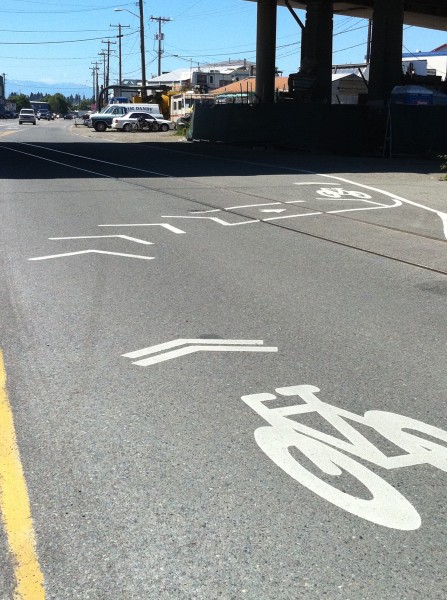 In a somewhat new twist on the never-ending Burke-Gilman Missing Link saga, a group of people who were injured crossing the railroad tracks under the Ballard Bridge have offered to pay for what they see as a fix.
In a somewhat new twist on the never-ending Burke-Gilman Missing Link saga, a group of people who were injured crossing the railroad tracks under the Ballard Bridge have offered to pay for what they see as a fix.
From Danny Westneat at the Seattle Times:
It’s been dubbed “the most dangerous street in Seattle.”
— Advertisement —
It’s the site, one local bicycling blog said, of a decade’s worth of “paint, spilled blood, signatures, band-aids, concussions, a ghost bike, and many, many crashes.”
Now, for the umpteenth time, some of its victims are calling for it to be fixed.
Only there’s a twist. The injured this time are so frustrated they’re offering to pay for the road work themselves.
Last week, another lawsuit was settled in the endless Ballard “missing link” bike-trail saga. Seven bicyclists, who crashed when their tires caught on odd-angle railroad tracks, were awarded a total of $755,000, mostly to pay their medical bills. (The payout is from insurance, not from taxpayers.)
So while the city’s approved and funded trail connection languishes due to appeals from some Ballard business interests, this group hired their own traffic engineer to find a solution to the crossing. They are even offering to pay the $13,680 they say it would cost the city to install a “rubberized filler system” at the crossing.
A lawyer with the city attorney’s office said the city is not sure it will work and insists that the city’s plans to extend the trial is the solution. Closing arguments in the latest appeal to the Hearing Examiner over the city’s trail plans were due June 17, and the decision is pending.
The rubberized solution the group wants to install would be different from the rubber pad that has caused many falls just a little bit down the tracks near NE 41st St. The city and the Ballard Terminal Railroad are working to fix that crossing because it can become slippery when wet.








Comments
6 responses to “Westneat: People injured by Missing Link offer to pay for a fix”
I really like this groups ability to go out and find a solution. Back in 2005, iirc, I ran across a guy who had taken a somewhat serious spill there. He clearly had suffered a concussion, and after everyone had abandoned him, including myself initially, I returned twenty minutes later to still find him standing there, dazed and confused in the literal sense.
So I slowly put him in my pick-up and his bike in back, took him to my work and then after awhile proceeded to get his name and where he worked, he couldn’t remember his own address. Fortunately I was able to contact his supervisor and they notified his relatives while I had the medics come and take him to Harborview.
In the end he was OK, the next day he walked into my work and didn’t even recognize me, understandably. He had brought a gift basket, which I politely declined and asked that he feed some homeless guys instead with it. We were just glad that he turned out alright.
Well maybe those incidents will be a thing of the past now. I wish the group best of luck!
Am I missing something here? Why is the city being villified and treated as if it isn’t doing anything about this?
A-The city keeps getting sued but wants to finish the trail, right?
B- Since this is to fix the problem with the crossing at the track, isn’t the one responsible for fixing it the guy who owns that train and its tracks? Just like he’s on the hook to pay for the rubber mat replacement near 41st?
What am I missing/forgetting?
That’s a good question. I know BTR is responsible for trail crossings, but this is a road crossing (because, as we all know, there is no trail). I don’t know if the rules are the same. I’ll see if I can find out.
One more note about BTR: In Westneat’s column, the operator of the railroad talks about putting his own warning signs up after the city failed for so long to provide any kind of reasonable warning to cyclists. He said the city made him take them down because they were non-standard and unapproved.
I saw that about the signs. But as someone who has been following this for a long time, and as someone with a sketchy memory at times, I remember the owner of that railroad saying at one time that he couldn’t afford to repair the road crossings in that area even though it was his responsibility. As I say, my memory could be faulty here, but if it’s right, I’m surprised to hear he put up signs (would love to see what they looked like!) and wonder if he is responsible, if he’d take the money from these people and do the work.
As for the road vs. trail crossing thing, I bet you find it is his responsibility. My guess is he has to do it on the trail because his private rails are on the city ROW. Same goes for the road, right?
Thanks for looking into it!
I’ve always wondered why, in all of these stories of sketchy railroad crossings, no one has brought up the prospect of “rubberized fillers.” Just google “flange gap filler” or “flangeway gap filler” and you will see an fair amount of products (VeloSTRAIL), research, and discussion on this solution. It seems like there is either a lack of experience and mistrust of the technology or they have never looked into it.
[…] clearly poses an unacceptable danger. It’s so bad that crash victims have even offered to help pay out of their own pockets to make it […]